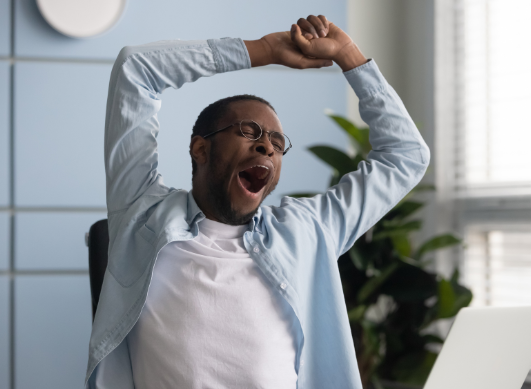CPAP for Sleep Apnoea: What are its side effects?
Published 10 May 2024 • By Somya Pokharna
Struggling with sleep apnoea can be exhausting, and while CPAP therapy offers much-needed relief, it's not without its challenges. From dry nose and mouth to skin irritation, the side effects can make consistent nightly use a huge hassle.
So, what are the various side effects of CPAP therapy? How can they be prevented or treated?
Read on to find out!

What is CPAP therapy? How does it treat sleep apnoea?
Continuous Positive Airway Pressure (CPAP) therapy is the frontline treatment for obstructive sleep apnoea, a condition where the airway collapses or becomes blocked during sleep, causing breathing issues. CPAP machines deliver air through a hose to a mask covering the nose or both the nose and mouth. This mechanism provides a continuous stream of air at a pressure sufficient to act as a pneumatic splint, thus keeping the airway open throughout the night.
This consistent airflow prevents frequent airway collapses linked to sleep apnoea, thereby preventing some potentially severe health consequences, such as cardiovascular diseases, diabetes, and cognitive impairments. Regular use of CPAP has been shown to significantly improve sleep quality, reduce daytime sleepiness, enhance cognitive function, and decrease the overall risk of severe health complications. Moreover, ongoing CPAP therapy has been linked to improvements in emotional stability, increased alertness, and better quality of life, demonstrating its comprehensive benefits beyond merely treating sleep apnoea.
Nonetheless, the side effects associated with CPAP therapy can sometimes discourage users from continuing with their prescribed treatment.
What are some common side effects of CPAP therapy?
Although the benefits of using CPAP therapy far outweigh the negative effects listed below, they can still be quite bothersome for users:
Dry mouth and nasal congestion
CPAP therapy can lead to both dry mouth and nasal congestion, complications that arise due to the continuous flow of pressurized air.
For those breathing through the mouth, particularly with machines that only cover the nose, dry mouth becomes a significant issue. The pressurized air escaping through the mouth during sleep exacerbates this condition, increasing the risk of gum disease, tooth decay, bad breath, and mouth sores over time.
Similarly, the forced air can irritate the nasal passages, leading to symptoms like a stuffy or runny nose, a burning sensation, irritation, and occasional nosebleeds. This effect is particularly noticeable in individuals prone to frequent sinus infections. Continuous dryness in the nasal area can increase sensitivity, pain, and even lead to chronic nosebleeds and sinus infections, potentially altering the sense of smell.
Skin irritation and pressure sores
One of the most common side effects of CPAP therapy includes skin irritation and the development of red marks from the headgear. These marks often appear along the cheeks or nose and may become tender to the touch. This happens due to the accumulation of facial oils, sweat, dirt, and dead skin cells when using the CPAP mask on a nightly basis. If not regularly cleaned, these contaminants significantly increase the risk of skin irritation and skin issues like acne every time the mask is worn. While trying to secure the mask, it's also common to overtighten the headgear. Unfortunately, this can lead to pressure sores and exacerbate skin irritation, making consistent use uncomfortable.
Eye irritation
Improperly fitted CPAP masks may lead to air leakage, causing dry and irritated eyes due to air dispersing from the bridge of the nose or around the mask. This leakage is often made worse by changes in sleeping positions.
Furthermore, inadequate mask cleaning can trap bacteria under the mask, potentially leading to eye infections as the bacteria are forced upward, either through air leaks or tear ducts.
Claustrophobia and anxiety
Wearing a CPAP mask can trigger feelings of claustrophobia and anxiety, and sometimes even panic attacks, particularly for new users, rendering them unable to relax or fall asleep. This fear of enclosed spaces is often aggravated when the mask tightly covers the nose, inducing feelings of smothering and suffocation. Full face masks that cover both the nose and mouth are also much more likely to induce claustrophobia compared to nasal pillow masks.
Aerophagia
Approximately 16% of CPAP users experience aerophagia, which is the medical term for swallowing too much air, resulting in abdominal discomfort, excessive gas, and bloating. This discomfort can occur when the air pressure of the CPAP machine is either too high or too low, leading to the admission of air into the gastrointestinal system. If the pressure is too high, it's easy to inadvertently swallow excess air, while too low a pressure may result in gulping air during sleep apnoea episodes.
Headaches
Wearing a mask that is too tight or experiencing high air pressure during CPAP therapy may lead to headaches. This occurs because the constant pressure on the nasal wall can cause inflammation and blocked sinuses, aggravating headaches. Additionally, tight headgear can exert pressure on specific areas of your head and neck, resulting in muscle tension and tenderness.
Upper respiratory or sinus infections
The constant flow of air from a CPAP machine can irritate and dry out the mucosal lining of the respiratory tract, which may lead to upper respiratory or sinus infections if the device is not regularly cleaned or properly humidified.
Noise disturbance
CPAP models vary in their noise levels during operation, potentially disrupting a bed partner's sleep. Additionally, air escaping from the mask can contribute to noisy disturbances during sleep.
How can the side effects of CPAP be prevented or treated?
To prevent or treat the side effects of CPAP therapy, several strategies can be considered:
- Start with lower pressure settings and gradually increase them as you become more comfortable with the therapy. This can help your body acclimate to the airflow and reduce discomfort.
- Ensure that your CPAP mask fits properly and comfortably. A well-fitted mask can minimize air leaks and reduce discomfort.
- Use a CPAP machine with a humidifier, or add a separate humidifier to your setup. Moistening the air can help prevent dryness in the throat and nasal passages, reducing irritation.
- Keep your CPAP equipment clean by washing the mask, tubing, and humidifier chamber regularly. This prevents the buildup of bacteria and mould, which can cause respiratory issues.
- Experiment with different sleeping positions to find one that is most comfortable for using the CPAP machine. Elevating your head with pillows can sometimes alleviate discomfort.
- Address any nasal congestion or allergies that could interfere with CPAP therapy. Using nasal decongestants or saline sprays before bedtime may help clear your airways.
It is important to use your CPAP machine consistently for effective management of sleep apnoea. If you encounter any side effects, make sure to discuss them promptly with your doctor. While you can try the practical solutions recommended above independently, your doctor can provide tailored advice to ease discomfort or potential long-term issues. Additionally, consult your doctor if your sleep apnoea symptoms persist despite CPAP therapy or if you have concerns regarding the correct pressure settings for your machine.
Was this article helpful to you?
Give it a "Like" and share your thoughts and questions with the community in the comments below!
Take care!
Sources:
Common CPAP Side Effects and Prevention — SleepApnea.org
Common Side Effects of CPAP — Sleep Foundation
Symptoms of Aerophagia Are Common in Patients on Continuous Positive Airway Pressure Therapy and Are Related to the Presence of Nighttime Gastroesophageal Reflux — Shepherd, K., Hillman, D., & Eastwood, P. (2013). Journal of clinical sleep medicine, 9(1), 13–17.
Top 9 Most Common CPAP Side Effects (plus How to Fix Them!) — CPAP.com
4 comments
You will also like

Fighting schizophrenia symptoms: a long journey against paranoia after detainment and denial
12 Dec 2018 • 7 comments

 Facebook
Facebook Twitter
Twitter





